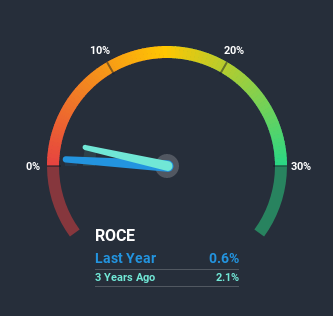
If we're looking to avoid a business that is in decline, what are the trends that can warn us ahead of time? Typically, we'll see the trend of both return on capital employed (ROCE) declining and this usually coincides with a decreasing amount of capital employed. This indicates the company is producing less profit from its investments and its total assets are decreasing. On that note, looking into Hotel Royal (SGX:H12), we weren't too upbeat about how things were going.
Return On Capital Employed (ROCE): What is it?
For those who don't know, ROCE is a measure of a company's yearly pre-tax profit (its return), relative to the capital employed in the business. The formula for this calculation on Hotel Royal is:
Return on Capital Employed = Earnings Before Interest and Tax (EBIT) ÷ (Total Assets - Current Liabilities)
0.0062 = S$5.1m ÷ (S$834m - S$20m) (Based on the trailing twelve months to June 2020).
So, Hotel Royal has an ROCE of 0.6%. Ultimately, that's a low return and it under-performs the Hospitality industry average of 2.3%.
See our latest analysis for Hotel Royal

Historical performance is a great place to start when researching a stock so above you can see the gauge for Hotel Royal's ROCE against it's prior returns. If you'd like to look at how Hotel Royal has performed in the past in other metrics, you can view this free graph of past earnings, revenue and cash flow.
So How Is Hotel Royal's ROCE Trending?
In terms of Hotel Royal's historical ROCE movements, the trend doesn't inspire confidence. To be more specific, the ROCE was 2.2% five years ago, but since then it has dropped noticeably. And on the capital employed front, the business is utilizing roughly the same amount of capital as it was back then. This combination can be indicative of a mature business that still has areas to deploy capital, but the returns received aren't as high due potentially to new competition or smaller margins. If these trends continue, we wouldn't expect Hotel Royal to turn into a multi-bagger.
Our Take On Hotel Royal's ROCE
All in all, the lower returns from the same amount of capital employed aren't exactly signs of a compounding machine. It should come as no surprise then that the stock has fallen 13% over the last five years, so it looks like investors are recognizing these changes. With underlying trends that aren't great in these areas, we'd consider looking elsewhere.
On a separate note, we've found 1 warning sign for Hotel Royal you'll probably want to know about.
While Hotel Royal may not currently earn the highest returns, we've compiled a list of companies that currently earn more than 25% return on equity. Check out this free list here.
If you decide to trade Hotel Royal, use the lowest-cost* platform that is rated #1 Overall by Barron’s, Interactive Brokers. Trade stocks, options, futures, forex, bonds and funds on 135 markets, all from a single integrated account. Promoted
Valuation is complex, but we're here to simplify it.
Discover if Hotel Royal might be undervalued or overvalued with our detailed analysis, featuring fair value estimates, potential risks, dividends, insider trades, and its financial condition.
Access Free AnalysisThis article by Simply Wall St is general in nature. It does not constitute a recommendation to buy or sell any stock, and does not take account of your objectives, or your financial situation. We aim to bring you long-term focused analysis driven by fundamental data. Note that our analysis may not factor in the latest price-sensitive company announcements or qualitative material. Simply Wall St has no position in any stocks mentioned.
*Interactive Brokers Rated Lowest Cost Broker by StockBrokers.com Annual Online Review 2020
Have feedback on this article? Concerned about the content? Get in touch with us directly. Alternatively, email editorial-team@simplywallst.com.
About SGX:H12
Hotel Royal
An investment holding company, operates in the hotelier business in Singapore, Malaysia, Thailand, and New Zealand.
Acceptable track record with imperfect balance sheet.
Market Insights
Community Narratives





